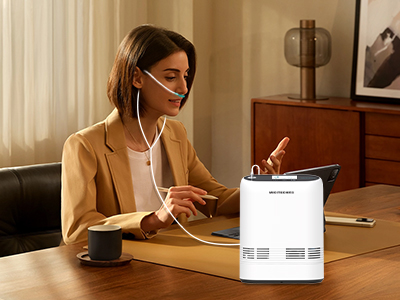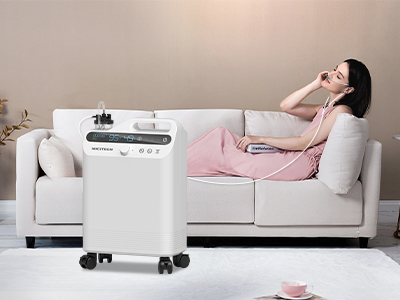13 May 2025
Gone are the days when oxygen therapy meant confinement. For decades, mobility and medical support existed in tension, shackling people to their homes or bulky tanks. But now? The rules have changed. With the rise of compact, efficient portable oxygen concentrators (POCs), individuals are reclaiming their freedom—one breath, one adventure, one step at a time.

Understanding Portable Oxygen Concentrators (POCs)
At its core, a POC is a marvel of miniaturization. Unlike traditional oxygen tanks, which store finite supplies of compressed oxygen, POCs extract and purify oxygen from ambient air in real time. This means they don’t run out—they breathe with you.
They’re lightweight, often no larger than a shoulder bag, and designed to be wheeled or slung across the body. With features like pulse-dose delivery, noise-reduction technology, and customizable flow settings, these aren’t just medical devices. They’re liberation machines.
Freedom to Roam: Travel Without the Tether
The world is vast, and it’s finally within reach. POCs are approved by the FAA for in-flight use, turning previously daunting air travel into a manageable affair. Trains, buses, cross-country RV escapades—suddenly nothing feels out of bounds.
Compact enough to slide under a plane seat yet powerful enough to support extended excursions, POCs enable users to transcend borders without lugging bulky canisters or stressing about refills.
Exercise and Physical Activity on Oxygen Support
Physical activity and oxygen therapy are no longer mutually exclusive. Thanks to POCs, users can stroll through parks, tackle beginner yoga sessions, or even hop on a stationary bike. With modern devices that automatically adjust delivery based on exertion levels, users can remain active without compromising oxygen saturation.
Wearable pulse oximeters help monitor progress, ensuring that each movement is safe and sustainable. It’s not just about lung capacity—it’s about life capacity.
Daily Errands and Social Engagements
Life is lived in the small things: picking up groceries, watching a grandchild’s recital, or sipping lattes with old friends. POCs fit seamlessly into the chaos and charm of daily routines. With whisper-quiet operation and unassuming designs, these devices empower users to reclaim spontaneity without drawing attention.
No more skipping dinners or canceling weekend plans. Portable oxygen therapy becomes an unobtrusive passenger in your journey—not the driver.

Battery Life and Power Management Strategies
Battery life is the lifeblood of POC users on the move. Fortunately, most devices offer extended-life batteries, hot-swappable options, and even dual-battery configurations. A savvy user knows their runtime like a pilot knows fuel levels.
Innovative accessories like solar charging panels or DC car adapters mean power is rarely out of reach. Planning becomes second nature—pack an extra battery, know your charging stations, and stay plugged in to freedom.
Discreet Design and Confidence in Public
Gone are the beige, bulky, plastic monstrosities of yesteryear. Modern POCs are sleeker than a Scandinavian backpack. Matte finishes, ergonomic straps, and minimalist interfaces let them blend effortlessly into public settings.
This isn't just cosmetic. It’s psychological. When you feel less like a patient and more like a person, confidence follows. And with confidence comes the courage to step out, show up, and shine.
Safety Tips for the Active User
A few ground rules keep things smooth on the road to independence. Avoid direct sun on your device. Ensure tubing isn’t a tripping hazard. Always have a backup plan—extra batteries, a charging port, a medical ID card.
Whether hiking a trail or navigating an art gallery, smart preparation is your silent bodyguard. The goal is adventure—not accident.
Success Stories: Living Beyond Diagnosis
Martha hiked the Appalachian foothills on her 70th birthday. Jamal ran a 5K with his POC clipped to his hydration vest. Their diagnoses didn’t define them—determination did. These aren’t isolated tales; they’re the new norm.
Staying active doesn’t just improve physical health. It stokes the spirit. Every walk, every conversation, every laugh becomes a testament to resilience and reinvention.
Conclusion: The Breath of Freedom
The portable oxygen concentrator isn’t just a device—it’s a declaration. A declaration that chronic conditions don’t eclipse ambition. That breathing support doesn’t equal boundary.
With the right tools, the right mindset, and the right plan, life opens up in spectacular ways. And every breath becomes a step toward joy, purpose, and unrestrained possibility.Apnea, or brief pauses in breathing, can be terrifying to witness. While occasional pauses are normal for very young infants, frequent or prolonged episodes are cause for concern. These interruptions may reduce oxygen supply to the brain and other organs.
Oxygen therapy can help stabilize these patterns, particularly in premature infants or those with underdeveloped neurological respiratory control. Monitors may help catch these pauses, but attentive observation is equally critical.
Low Oxygen Saturation Levels on Monitoring
Pulse oximetry—a simple, non-invasive test using a sensor on the foot or finger—measures the percentage of oxygen in the blood. For most healthy infants, oxygen saturation should stay between 95–100%. Levels consistently below 90% are a major warning sign.
Doctors use this data as a cornerstone in determining the need for oxygen therapy. It's one of the few objective, measurable tools that directly reflects how well your baby is oxygenating.
Chronic Lung Conditions and Prematurity
Some babies are born with a steeper hill to climb. Preemies, especially those with bronchopulmonary dysplasia (BPD), often require supplemental oxygen to support underdeveloped lungs. In these cases, oxygen therapy isn’t just a reaction—it’s part of a long-term care plan.
Other chronic conditions like congenital heart defects or respiratory infections can also deplete oxygen levels. In these contexts, supplemental oxygen acts as both a treatment and a protective barrier against complications.
Physician Evaluation and Diagnosis
The signs may start at home, but the decisions should rest with trained professionals. Pediatricians and neonatologists assess multiple factors: physical signs, oximeter readings, lab work, and imaging studies.
If oxygen therapy is deemed necessary, it may be administered in a neonatal intensive care unit (NICU) or even at home through portable equipment. The goal is always the same—stabilize, support, and strengthen the baby’s ability to breathe unaided.
Conclusion: Supporting Your Baby’s Breath, Every Step of the Way
Breathing is life’s first and most essential task. When that task is compromised, oxygen therapy becomes an invisible but powerful ally. Watching for the signs—rapid breathing, cyanosis, poor feeding, apnea—can be the difference between delay and decisive care.
Your vigilance, paired with professional insight, ensures your baby is not just breathing—but thriving.
But support is everywhere. Counseling, peer support groups, mindfulness apps, and even journaling can help recalibrate your mental landscape. You are not defined by your equipment; you are defined by your resilience and how you rise, breath by precious breath.
Emergency Preparedness and Backup Plans
What happens if the power goes out? If you’re using an electric concentrator, a blackout could cut off your oxygen source. That’s why backup oxygen tanks—preferably filled and easily accessible—are non-negotiable.
Keep batteries charged for portable concentrators. Know where the nearest emergency services are. Build a kit: extra cannulas, masks, extension tubing, a flashlight, batteries, and copies of your oxygen prescription. Planning for the worst ensures you breathe calmly through anything.
Conclusion: Redefining Independence with Every Breath
Home oxygen therapy is not a limitation. It’s a liberation. With each inhale, you’re reclaiming autonomy, pushing boundaries, and writing a new script—one rich with potential and perseverance.
Transitions are rarely effortless, but with preparation and the right mindset, they become transformative. So take that first step. Breathe in. Move forward. Home is ready—and so are you.
Keywords: oxygen concentrator
Originally published 13 May 2025, updated 13 May 2025.